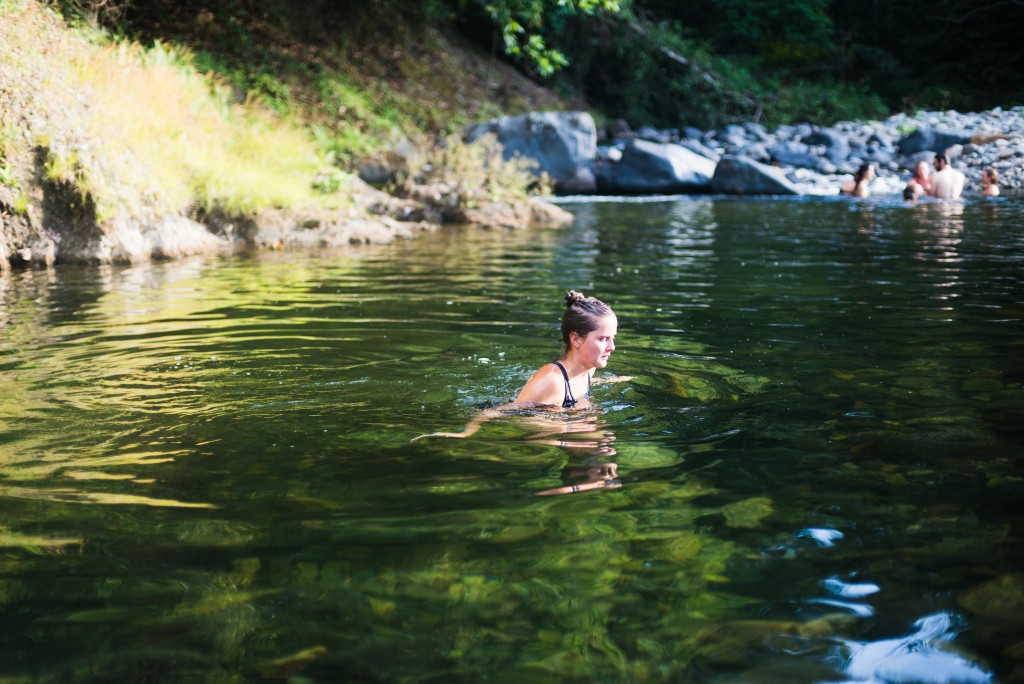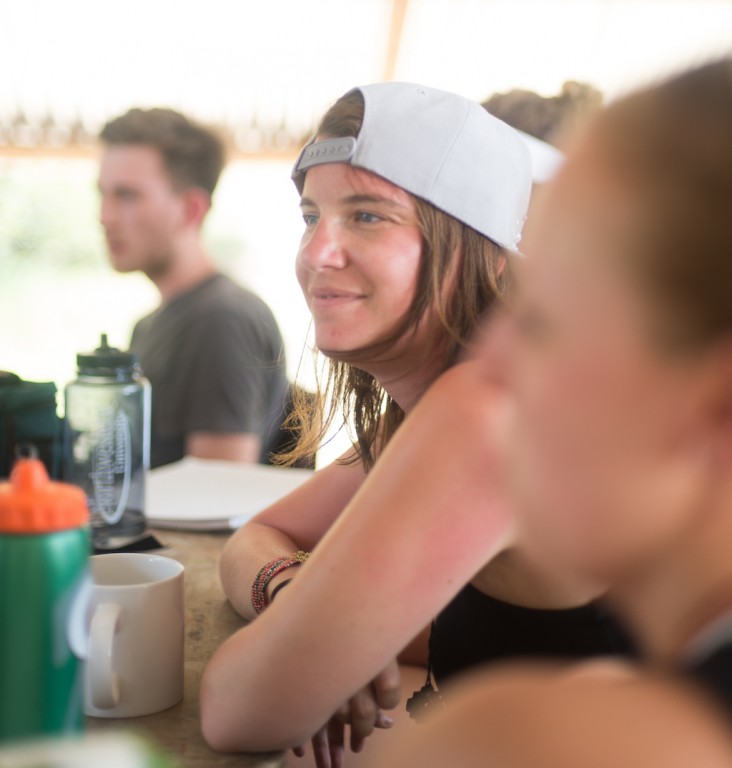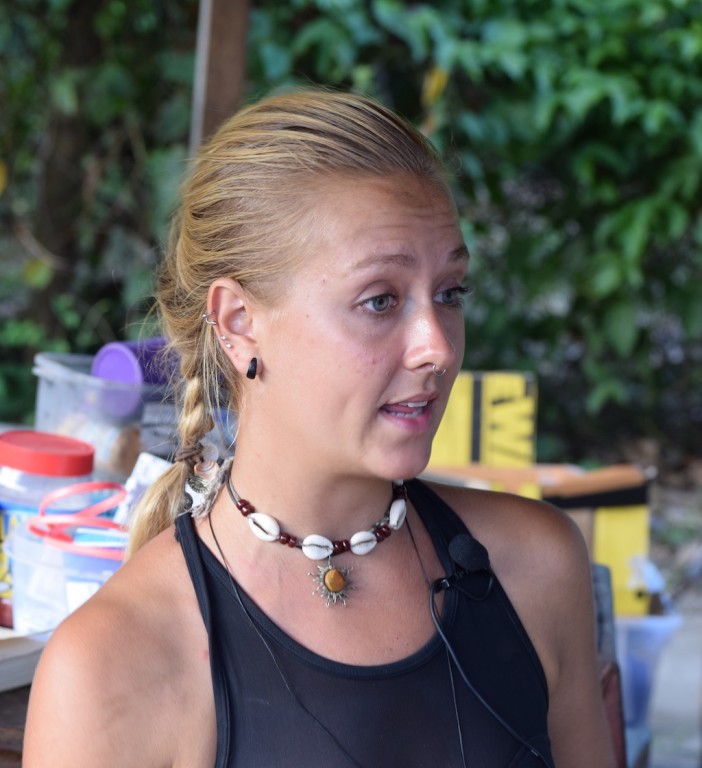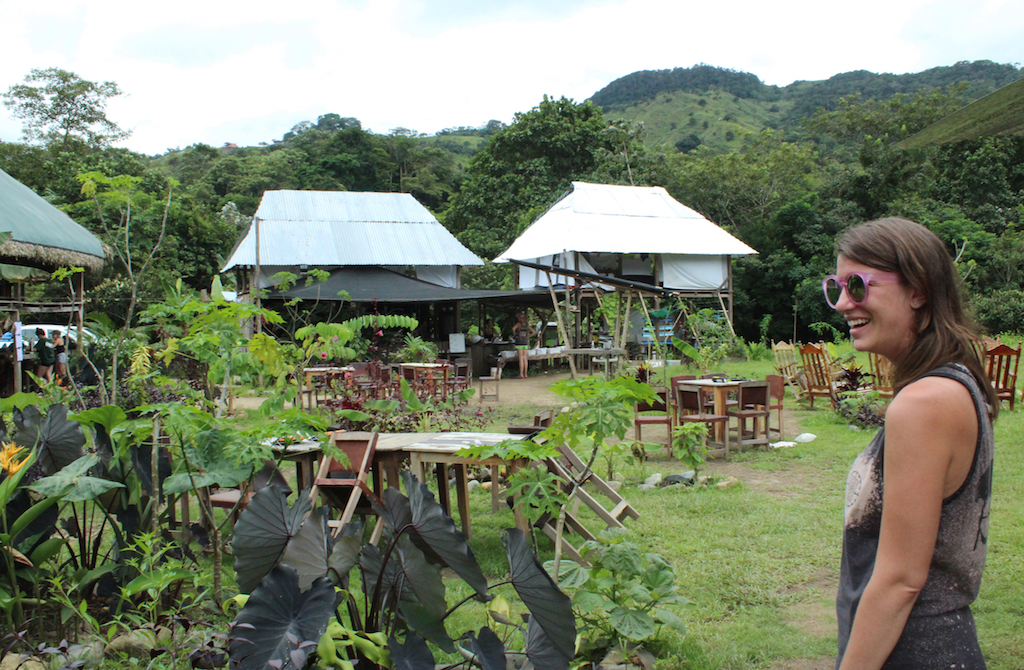
Harper Simpson, former agriculture intern at Kalu Yala, wears jewelry to remind her to stay strong in times of hardship. (Cassandra Majewski/Medill)

Harper Simpson, former agriculture intern at Kalu Yala, wears jewelry to remind her to stay strong in times of hardship. (Cassandra Majewski/Medill)
By Ashley Hackett
From the outside, the eco-town Kalu Yala seems to fit the description of a jungle utopia. Beautiful twenty-somethings with edgy tribal tattoos, perfectly bronzed skin and wiry, athletic bodies walk barefoot through a town square filled with hammocks and raised platform huts.
They are pushing wheelbarrows filled with dirt, sawing wood for a table, painting educational signs, planting seeds for harvests that feed the community, running on a forest path that leads to the cool río. A wild paradise.

Many interns find the 10-week stay transformative, in pursuit of ecological skills and new friends. But just as a beautiful face can sometimes hide a tortured soul, the outward beauty and serenity of Kalu Yala is only the surface level to the emotions that can run in an undercurrent of the jungle town. In a place so focused on environmental sustainability, an important caveat at Kalu Yala is its struggle to create an environment that is mentally sustainable.
“This place is an emotional rollercoaster for some reason,” said Brett Towle, a 20-year-old design thinking intern at Kalu Yala. “It has a lot to do with the conditions you’re working in, the close quarters. You go through this honeymoon phase at the beginning, like, ‘This is paradise, how could I ever be upset here?’ Then, you start working and realize there’s serious lack of resources, there’s a lot of lack of communication between employees, and getting materials for projects is very difficult.”

Towle, a student at the University of Virginia, spoke of the hard times of his stint at Kalu Yala in retrospect. After the “honeymoon phase” of the first few weeks in the jungle wears off, many interns – including Towle – reported that the grueling conditions and forced camaraderie made life in the jungle difficult. In his ninth week out of the 10-week program, he felt that life at Kalu Yala now seemed a lot rosier in retrospect.
Although the outdoor life can be therapeutic for many people, basking in sunlight and working with the land is not always enough for everyone to overcome more deep-seated mental and physical challenges.
“I’ve dealt with major depression since I was a kid, and I had it under control for most of my adult life. I was never really impacted, and if I had issues I dealt with it on the side,” said 32-year-old Carly Schwartz as she reflected on her truncated time at Kalu Yala.
Schwartz, the editor-in-chief of Google Insider, first arrived in Kalu Yala in September 2016 to kickstart the media program there. After writing an article on Kalu Yala as deputy national editor at the Huffington Post, the eco-city captivated her. Her first few weeks in the jungle were filled with the same ecstasy that inspires many who embark on the 10-week odyssey in the wilderness. As time wore on, however, things took a turn for the worse.
“When I got to Kalu Yala, I was so euphoric and activated by the ideas and hope and possibilities that I stopped taking my meds because I thought I was cured,” Schwartz said. “I realized almost immediately that was a grave mistake.”

Although Schwartz could tell that something was off at first, she ignored the feeling. Gradually, however, she felt herself slipping back into depression.
“A month or two later, I opened my eyes and realized, ‘Wow – I’m really stressed. I can’t function this way,’” she said.
Schwartz’s experience at Kalu Yala is one of pain and struggle that worsened her condition after she went off of her medication. However, many interns reported gaining confidence and kicking some of their issues they struggled with in civilization. Samantha Picker, a community wellness intern from Australia, felt that coming to Kalu Yala was her biggest step in coming to terms with her own mental unrest.
“It’s easier to feel your self-worth here because you feel the weight of other people and you realize, ‘Oh, I’m actually worth something here,’” the 25-year-old said. “Some people here came in and were dealing with stuff. When you get here, you’re living [in close quarters with] 50 people in a way that you’re not used to. If you have anything emotional underneath, it’s surfaced. You can’t run away. But for me, that was a good thing; I realized that it wasn’t harming me.”

And the work is inventive, with interns designing new kinds of sustainable housing or helping to create new recipes for biofuels using waste products. But what works so well for some people at Kalu Yala does not work for others, a distinction between someone struggling with a troubled past and someone diagnosed with a mental health illness or disorder.
According to the Anxiety and Depression Association of America, major depressive disorder “affects more than 15 million American adults, or about 6.7 percent of the U.S. population age 18 and older in a given year.” Diagnosed depression is not the same as feeling sad from a breakup or loneliness or even a death in the family. It is a heavy feeling that people experience daily or nearly daily for no apparent reason. Depression can be due to a simple chemical imbalance, and is often successfully treated with medication, for good reason.
Kalu Yala has limited access to hospitals and advanced clinics, and interns are expected to bring their own medications. The nearest hospital is a two-hour drive or, in an emergency, a 30-minute helicopter ride. The nearest clinic in the small town of San Miguel offers prescriptions, though not to the capacity of most pharmacies in the United States. With these limited medical resources, supporting someone with a preexisting chronic mental illness or health issue proves tricky. Community nurse Michele Conlin said Kalu Yala meets these challenges with pre-screening and on-site care.

“People have to fill out a very complete form about prior history of both physical and mental health issues, so if at the beginning of the semester I have to address any issues, I’ll talk to people directly,” said Conlin, also the head of safety at Kalu Yala. “We are very specific when people are enrolling that this is a remote area, that we are within a two-hour drive to the nearest hospital. We do make that disclaimer when people come.”
Healthcare accessibility became a major issue when Schwartz needed it most and ultimately decided to leave Kalu Yala.
“People who deal with depression on a regular basis and think they can come to Kalu Yala and find some sort of treatment cure are in for a rude awakening,” Schwartz said. “It was the opposite of rehab for me. There was no alone time, and it’s a harsh environment with 80 others your own age and nowhere to go if you need to be alone or have privacy to deal with traumatic feelings or events. I didn’t want to talk to people about [my depression], and as a leader I didn’t feel like I could be super vulnerable.”
Schwartz fought her condition for weeks, but eventually had to go home to San Francisco where she sought help to regain control. “In retrospect, if I hadn’t gone off my meds I probably would have stayed through the end of the semester, but I don’t think I would have moved to Kalu Yala,” Schwartz said.
And now, Kalu Yala executives plan to expand the eco-city to include even more developed land and more staff and interns. If adventurous twenty-somethings continue to trek into the jungle prepared to manage their own mental and physical health conditions, the eco-city should be safe – relative to the challenges of jungle living – and sustainably run.
But for those like Schwartz, facing intense labor and incredible growth while managing a diagnosed chronic illnesses, the eco-town becomes as foggy as the jungle’s early mornings.

“Now that I’m in a good place, I absolutely would go back again,” Schwartz said. “But Kalu Yala is not the place you can go and take mental illness lightly. And you certainly can’t go thinking that you’re going to cure yourself. If you do that, you’ll end up eaten alive.”